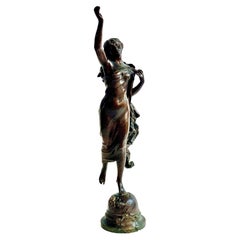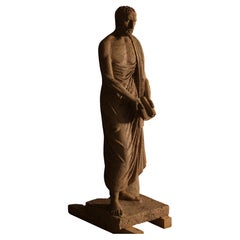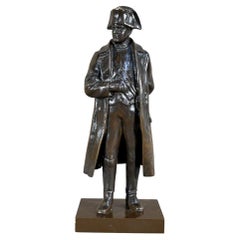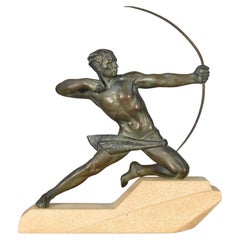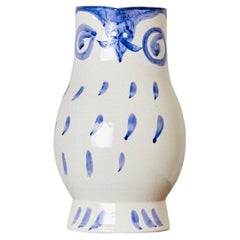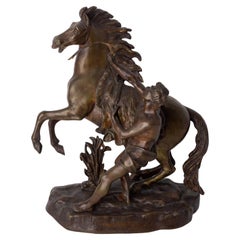France Figurative Sculptures
to
131
973
291
58
148
260
565
349
172
188
75
25
8
80
44
22
37
31
33
15
15
194
105
54
53
50
43
9
9
5
3
2
565
408
306
229
221
1,322
7,749
7,609
1,091
779
92
43
39
Height
to
Width
to
1,322
1,125
1,206
18
17
17
9
7
Item Ships From: France
19th Century Tall and Large Woman Bronze Statue by French Sculptor Adrien Gaudez
By Adrien Étienne Gaudez
Located in LA CIOTAT, FR
'L'Etoile du Matin', an Art Nouveau patinated bronze sculpture by renowned French sculptor Adrien Etienne Gaudez (1845 – 1902). This evocative piece depicts a mythological lady in fl...
Category
19th Century French Antique France Figurative Sculptures
Materials
Bronze
Statue sculpture life size antique old Roman Greek stone reclaimed carving decor
Located in Costa Mesa, CA
Antique statue life sized Roman Greek natural stone old sculpture.
The antique statue displayed in this Ad is one of 12 reclaimed life sized limestone statues.
In this specific ...
Category
18th Century French Rustic Antique France Figurative Sculptures
Materials
Limestone
Bronze sculpture “Napoleon Bonaparte” – Early 20th century
Located in HÉRIC, FR
Bronze with a brown patina, depicting Napoleon Bonaparte (1769-1821), wearing his famous bicorne hat, standing, his right hand in his waistcoat and the other behind his back, holding...
Category
Early 20th Century French France Figurative Sculptures
Materials
Bronze
Art Deco Sculpture The Archer Hercules by Max Le Verrier
By Max Le Verrier
Located in SAINTE-COLOMBE, FR
Art Deco Sculpture The Archer Hercules by Max Le Verrier
This sculpture shows the classic pose of The Archer / Hercules, son of Zeus, drawing his bow....
Category
Early 20th Century French Art Deco France Figurative Sculptures
Materials
Stone, Bronze, Spelter
Pablo Picasso, Hibou, 1954, Pichet tourné, édition Picasso, Madoura
By Pablo Picasso, Madoura
Located in Nice, Cote d' Azur
Pablo Picasso
Hibou
1954
Pichet tourné
H. 24,5 cm. Larg 13 cm
R.A terre de faience blanche, décor à l'oxyde sur émail blanc
Bleu
Tiré à 500 exemplaires
Edition Picasso, Madoura.
Répe...
Category
1950s French Modern Vintage France Figurative Sculptures
Materials
Ceramic
Bronze Cheval De Marly in the Style of Guillaume Coustou, circa 1930
Located in Labrit, Landes
Bronze statue in the style of Guillaume Marly.
The horses of Marly were commissioned by Louis XV to sculptor Guillaume Coustou to decorate the entrance of the park of Marly castle. ...
Category
19th Century French Antique France Figurative Sculptures
Materials
Bronze
Pierrot Polychrome Sculpture, 1900s
Located in Saint-Amans-des-Cots, FR
Pierrot under the Moon sculpture, France, ca.1900. Polychrome plaster and mirror. Pierrot sits on a stone balustrade and plays the mandolin under the moon. The moon is represented b...
Category
Early 1900s French Art Nouveau Antique France Figurative Sculptures
Materials
Mirror, Plaster
La Ferrari Sculpture
Located in Paris, FR
Sculpture La Ferrari with all structure in assembled aluminium pieces
(4mm thickness), all painted with original Ferrari rosso corsa paint.
Limited Editio...
Category
21st Century and Contemporary Belgian France Figurative Sculptures
Materials
Aluminum
$23,468
French Art Deco Ceramic Lady by ODYV, 1920
By ODYV
Located in Saint-Amans-des-Cots, FR
French Art Deco ceramic sculpture by BERLOT-MUSSIER (Vierzon), France, 1920s. Young Lady among flowers in the style of René Buthaud in colored crackle glaze ceramic. Measures: Height...
Category
1920s French Art Deco Vintage France Figurative Sculptures
Materials
Ceramic
Woman with Greyhounds in Patinated Metal, sculpture Art Deco – 1930
Located in HÉRIC, FR
This work depicts a woman accompanied by two greyhounds, made of metal with a patinated black and gold finish.
The young woman is walking her dogs on a leash, as suggested by the gol...
Category
Early 20th Century French Art Deco France Figurative Sculptures
Materials
Metal
CAMPBELL French Art Deco Man Sculpture, 1920
Located in Saint-Amans-des-Cots, FR
A striking French Art Deco sculpture of a man by Campbell, created in France ca.1920. Crafted from spelter, marble, and onyx, this impressive piece showcases the bold, dynamic style ...
Category
1920s French Art Deco Vintage France Figurative Sculptures
Materials
Onyx, Marble, Spelter
Demetre Chiparus Terracotta Lady Bust Sculpture, 1920
By Demetre Chiparus
Located in Saint-Amans-des-Cots, FR
French Art Deco Terracotta Sculpture by Demetre Chiparus (1886-1947), France, 1920s. This exquisite French Art Deco terracotta sculpture, created by the renowned artist Demetre Chipa...
Category
1920s French Art Deco Vintage France Figurative Sculptures
Materials
Terracotta
Roger Capron Ceramic Sculpture Bottle "Lavande", 1950s
By Roger Capron
Located in Paris, FR
Roger Capron (1922-2006)
Stylized woman ceramic bottle "Lavande" signed by Roger Capron, Vallauris, 1950s
Nice condition, with original glass bottle inside.
Category
1950s Vintage France Figurative Sculptures
Materials
Ceramic
Statue sculpture life size antique old Roman Greek stone reclaimed carving decor
Located in Costa Mesa, CA
Antique statue life sized Roman Greek natural stone old sculpture.
The antique statue displayed in this Ad is one of 12 reclaimed life sized limestone s...
Category
18th Century French Rustic Antique France Figurative Sculptures
Materials
Limestone
Statue sculpture life size antique old Roman Greek stone reclaimed carving decor
Located in Costa Mesa, CA
Antique statue life sized Roman Greek natural stone old sculpture.
The antique life sized statue displayed in this Ad is one of 12 reclaimed life sized ...
Category
18th Century French Rustic Antique France Figurative Sculptures
Materials
Limestone
Bronze Sculpture of a Gaulish Chief, Signed FREMIET.
By Emmanuel Fremiet
Located in Saint-Ouen, FR
Bronze sculpture of a Gaulish chief, signed FREMIET.
Bronze sculpture signed FREMIET, representing a Gaulish chief, 19th century, Napoleon III period.
H: 37cm, W: 26cm, D: 8,5cm
Category
19th Century French Napoleon III Antique France Figurative Sculptures
Materials
Bronze
Georges BASTARD Art Deco Showjumper Porcelain Bottle 1924, Paris Olympic Games
By Georges Bastard
Located in Saint-Amans-des-Cots, FR
French Art Deco showjumper porcelain bottle by Georges BASTARD (Paris), France, ca.1924. Designed by Margerie. White porcelain made in Limoges. Height : 10.5"(26.7cm), Width : 3.9"(1...
Category
1920s French Art Deco Vintage France Figurative Sculptures
Materials
Ceramic, Porcelain
Statue sculpture life size antique old Roman Greek stone reclaimed carving decor
Located in Costa Mesa, CA
Antique statue life sized Roman Greek natural stone old sculpture.
The antique statue displayed in this Ad is one of 12 reclaimed life sized limestone statues.
In this specific ...
Category
18th Century French Rustic Antique France Figurative Sculptures
Materials
Limestone
18th Century, Italian Carved Giltwood Wing of a Baroque Angel
Located in Buisson, FR
Beautiful Baroque hand carved wooden angel-wing. Rare and very decorative item placed on a wooden base, Italy, circa 1750. Weathered. Measurement is inclusive the wooden base.
Category
18th Century Italian Baroque Antique France Figurative Sculptures
Materials
Wood
$383 Sale Price
45% Off
Virgin and Child in Majesty
Located in Saint-Ouen, FR
Virgin and child in majesty
Origine: castille
Epoque: early 14th century
Measures: Height: 72cm
Length: 30cm
Depth: 25cm
Polychrome and gi...
Category
15th Century and Earlier Antique France Figurative Sculptures
Materials
Wood
$41,275
E. Hannaux : "Mercury and Cupid", patinated bronze sculpture C.1880
By Emmanuel Hannaux
Located in SAINT-OUEN-SUR-SEINE, FR
Emmanuel HANNAUX (1855-1934, France) : "Mercury and Cupid"
Nuanced brown patinated bronze showing latine god Mercury holding Cupid in its arms
Signed "E.Hannaux" on the rotating ba...
Category
1880s French Greek Revival Antique France Figurative Sculptures
Materials
Bronze
Ceramic Sculpture "Malin", Lisa Larson for Gustavsberg, Sweden 1961
Located in St Ouen, FR
Charming ceramic subject from the naive and warm world of Lisa Larson.
In perfect original condition, the piece is signed on both feet of the sculpture.
Lisa Larson - b.1931 d.2024 ...
Category
1960s Swedish Scandinavian Modern Vintage France Figurative Sculptures
Materials
Ceramic
Important Virgin and Child in Majesty
Located in Saint-Ouen, FR
Important virgin and child in majesty
Origin : Germany Or Eastern France
Époque : Second Half Of The 13th Century
Height: 104.5 cm
Length: 3...
Category
15th Century and Earlier Antique France Figurative Sculptures
Materials
Oak
R2D2 Life Size Model Sculpture Star Wars
Located in Paris, FR
Sculpture R2D2 life size model star wars.
Set upon a millennium falcon base.
sculpted in resin and with accurate lights and sounds.
With rotative hea...
Category
21st Century and Contemporary Australian France Figurative Sculptures
Materials
Resin
A Stellmacher, Terracotta Bust, Arab, 19th Century
By Riessner, Stellmacher & Kessel
Located in MARSEILLE, FR
Rare orientalist bust in polychrome terracotta of an Arab, bearing the mark R St K, for Riessner, Stellmacher and Kessel, as well as the number 1525
The features are very fine, maki...
Category
19th Century German Moorish Antique France Figurative Sculptures
Materials
Terracotta
Giraffe in Love XS Floor Lamp by Qeeboo, 2019
Located in Saint ouen, FR
Giraffe in Love XS floor lamp by Qeeboo
Collection:
Giraffe In Love
Type:
Floor lamp in glass resin
Materials:
Polyethylene (PE)
Designer:
M...
Category
2010s France Figurative Sculptures
Materials
Plastic
Religious Sculpture Representing the Nativity, Carved Wood from the 16th Century
Located in Saint-Ouen, FR
Religious sculpture representing the nativity, carved wood from the 16th century.
Carved wood sculpture, walnut wood and oak wood base, sculpture representing the nativity, circa 16...
Category
16th Century French Neoclassical Antique France Figurative Sculptures
Materials
Oak, Walnut
Set of 3 Metal CACTUS Contemporary BRUTALIST SCULPTURES by ESOJ France 2020
By (Circle of) Jan Weesop
Located in PARIS, FR
A set of 3 strong and spectacular metal cactus, contemporary brutalist sculptures, unique pieces by artist ESOJ, France 2020.
Dimensions :
The higher : H 101.5 x D 23 cm / H 40 x D 9 inch
The medium : H 50 x D 17 cm / H 20 x 6.7 inch
The smaller : H 21 x D 16,5 cm / H 8.2 x 6.5 inch
These pieces allow to be presented independently, as well as together (recommended) allowing various esthetic compositions. They are made to be set up indoor as radical sculptures, as well as outdoor on a terrasse or in any garden or even wild nature to create a trouble illusion between wildness and modernity.
We represent ESOJ and organized his exhibition "Metal Spirit", November 2022, in our gallery in Paris, and this unique piece was presented during this event.
Esoj's work is rooted in a direct link to daily life, to the visual value of consumer objects. Whether they are elements of nature or products of pop culture, he fixes them in the metal to give them a definitive appearance, a form of immortality: a box of opened chocolates will be there forever, nothing will not erase Mickey's sluggish smile, nor his middle finger; a succulent plant frozen in iron will no longer need water... A parallel world under construction, a world of avatars springing from a metallic quintessence which confronts man with himself, with matter, with progress, to the flow of time. Beyond their symbolic force, Esoj's sculptures express as much the visceral gesture of the artist in a world losing meaning, as they catalog his universe in a subjective archive.
For his first collaboration with us, Esoj looks away from his Barbie dolls, Playmobils and bags of M&Ms, to sketch a sort of return to Nature and vibrate an ancestral wisdom evident in his new series of cacti, succulents, vases and masks murals with shamanic connotations. A wisdom that he draws from his Portuguese origins, this saudade: “tension between opposites, on the one hand the feeling of a lack, on the other hand the hope and the desire to find what we lack”, embodied here by a particularly inhabited desert; where cacti are next to agaves, aloes, prickly pears, plants which are certainly ornamental but also hallucinogenic and healing, sometimes fatal; where the series of containers suggests an almost medicinal link between these inert objects, even more obvious in the wall piece inspired by Korean...
Category
2010s French Brutalist France Figurative Sculptures
Materials
Metal
Robj, Templars and Saracen Chess Set, French Art Deco 1920s
By ROBJ
Located in PARIS, FR
Superb and extremely rare ROBJ Templar and Saracen chess set from the French Art Deco Period circa 1930.
Beautiful and playful detail on the pieces. Exotic wood chess board of orig...
Category
1930s French Art Deco Vintage France Figurative Sculptures
Materials
Ceramic, Wood
French Art Deco Women Ceramic Sculpture Signed Louis Rivet, 1930s
Located in LEGNY, FR
Very beautiful art deco statue in cracked ceramic representing a woman coming out of the bath. Signed Louis Rivet on the base.
Very good quality and large s...
Category
1930s French Art Deco Vintage France Figurative Sculptures
Materials
Ceramic
$1,424 Sale Price
20% Off
Spanish 17th/ 18th Century Hand Carved Wooden Baroque Angel
Located in Buisson, FR
Wonderful hand carved standing Baroque angel figure. Unique period piece with its original paint .
Spain, circa 1650-1750
Weathered. .
Measurement here below includes the wooden ba...
Category
17th Century Spanish Baroque Antique France Figurative Sculptures
Materials
Wood
$878 Sale Price
44% Off
Art Deco Sculpture the Wounded Bird by H Moreau
By Hippolyte François Moreau
Located in NANTES, FR
Sculpture circa 1920 in spelter entitled "The Wounded Bird".
Executed by Hippolyte François Moreau.
Signed H Moreau.
Small chip on the marble, see on the l...
Category
1920s French Art Deco Vintage France Figurative Sculptures
Materials
Marble, Spelter
Sculpture Bloomen 14 by Zanellazine Ceramics
Located in Geneve, CH
Sculpture Bloomen 14 by Zanellazine Ceramics
Dimensions: W 26 x D 23 x H 43 cm
Materials: Red and white clay, Green semi-refractorie clay.
About:
Giovanna Zighetti, ceramist and se...
Category
2010s Italian Post-Modern France Figurative Sculptures
Materials
Ceramic
$2,594 / item
Important 14th Century Polychrome Limestone Virgin from Lorraine
Located in Saint-Ouen, FR
Provenance :
- Kunsthaus Heinrich Hahn, Frankfurt am Main, sale 16, June 17, 1930, lot 16.
- Sotheby's, Amsterdam, Feb. 26, 2006, lot 201.
HISTORIC
Located between Moselle valley and Meuse valley, framed by the Vosges Mountains on the south side and the duchy of Luxembourg on the north side, the duchy of Lorraine is the result of several partitions. It starts with the 9th century when the Carolingian empire is divided, with Lothar 1st inheriting Lotharingia. In 959 this territory was in turn divided in two; Lower and Upper Lotharingia, the latter being the forebear of the duchy of Lorraine. This duchy was under the rule of the Holy Roman Germanic Empire until 1736 when it was absorbed by the kingdom of France.
All along its history the duchy of Lorraine has found itself in the midst of many conflicts. Alliances and feuds marking European history were always particularly sensible in Lorraine where instability was frequent. Because of its geographic position the duchy of Lorraine was also an artistic crossroad.
Hence the duchy of Lorraine becomes from the 13th century onwards an important artistic centre where a particular type of Virgin and Child appears. According to professor J. A. Schmoll the characteristics of Lorraine sculpture burgeon around 1280-1300 in the Aube region. It presents “vigorous volumes, restrained movements, rare but solemn gestures and a strong interiorised and stern expression”. Those Virgins look similar with a wide forehead, a shield- or oval-shaped face, large neck, small lips and a cleft chin.
This model is particularly in favour during the 13th century because of the revival for Marial worship and for the theme of the Virgin and Child. It bears witness to a new religious sensibility with a more intimate vision of religious practice.
DESCRIPTION
The important 14th century Virgin we present to you is one of the most beautiful examples of sculptural art from Eastern France, with her fascinating distant gaze.
Her contrapposto posture is induced by the weight of the child she carries high on her left side. The child has a chubby face framed by blond hair with well defined curls and he wears a long red V-collared tunic from which emerge his feet. The fabric is animated by long folds. The position of the right foot turned to the back is a detail we can notice on several Virgins from Lorraine. He holds a bird that seems to be pecking his thumb.
“The bird /held by the child in his hands/ has been read as a reference to an episode from Christ’s childhood when he has moulded sparrows with clay before giving them life. It appears in the apocryphal gospel of Pseudo-Matthew (ch. 27) and later in the Quran (III, 43, v. 110). However the iconography seems to be more influenced by the concept of Redemption or of Eucharist, the bird symbolising the soul of the Christian about to be redeemed or revitalised.”
Mary wears a long dress with two rock crystal cabochons remaining from the original five. She is covered by a red cloak enriched with old-gold motifs draped as an apron falling in long pleats along her left hip. The relief treatment and the volume of the cloak developing a network of concentric pleats contrast with the the flat pleating of her dress. They nevertheless suggest the curve of her bent right leg.
She wears a floret crown securing a short thin veil carved in very low relief. From it emerges her blond curled hair characteristic of the 13th century. The large face with almond-shaped eyes, straight nose, small lips and cleft chin casts its gaze afar in a fashion typical of 13th century Virgins.
In her right hand she holds a lily flower. In a very refined manner the artist has carved a band on her right ring-finger.
In the back, carefully sculpted, spreads the minutely detailed short veil.
COMPARATIVE STUDIES
This sculpture of great quality presents obvious similarities with Virgins from Lorraine, designated by William Forsythe...
Category
15th Century and Earlier French Gothic Antique France Figurative Sculptures
Materials
Limestone
Chinese Carved Jade Figural Sculpture of Laughing Buddha, Budai, 20th Century
Located in Auribeau sur Siagne, FR
This buddha is in Jade, in, a green color. He is sitted on his wood base.
It has been done in china during the 20th century.
Category
20th Century Chinese Chinoiserie France Figurative Sculptures
Materials
Jade
$330 Sale Price
20% Off
Decorative panel “Eva” in blue lacquered metal. Contemporary work.
Located in Saint-Ouen, FR
Antonine de Saint-Pierre, signed.
“Eva” bas-relief panel, in cut and blue lacquered metal.
Contemporary artist’s work signed and numbered.
Dimensions: H 139 x W 126 x D 8 cm
Ref...
Category
2010s European France Figurative Sculptures
Materials
Metal
Limoges Porcelain Pierrot Musician in White and Gold by Edouard Marcel Sandoz
By Theodore Haviland, Edouard-Marcel Sandoz
Located in Henley-on Thames, Oxfordshire
Edouard Marcel Sandoz
(1881-1971)
Figure "Pierrot Musicien", ca. 1917.
Hard-paste porcelain with a white glaze, and painted gold.
Signed to the base, appears to be Théodore Havil...
Category
Early 20th Century French Art Deco France Figurative Sculptures
Materials
Porcelain
Pirate Champagne Playmo Sculpture
Located in Paris, FR
Sculpture Pirate Champagne Playmo with all structure
in bio-based styrene plastic. Playmobil customized, hand-
painted as Ruinart champagne pirate with imitation Hermes
scarf, with...
Category
21st Century and Contemporary French France Figurative Sculptures
Materials
Plastic
Art Deco Terracotta Sculpture BrownColor Woman Head France 1980 Signed
Located in Auribeau sur Siagne, FR
Art Deco Terracotta Sculpture BrownColor Woman Head France 1980 Signed
Category
1980s French Romantic Vintage France Figurative Sculptures
Materials
Terracotta
$254 Sale Price
20% Off
Black Faun Wall Decorative Ceramic Mask circa 1950 French Midcentury
Located in Neuilly-en- sancerre, FR
Wall ceramic mask, circa 1950
French midcentury ceramic mask with elegant black ceramic glaze color.
Original perfect conditions
Measures: Height 24 cm, large 22 cm, depth 7...
Category
20th Century French Mid-Century Modern France Figurative Sculptures
Materials
Ceramic
Antonine de Saint Pierre. Sculpture “Eva”. Year 2024.
Located in Saint-Ouen, FR
Sculpture entitled “Eva” in black lacquered metal, a stabile whose different parts can be tilted to obtain different shapes resting on a rectangular travertine base.
Work of contemp...
Category
21st Century and Contemporary French France Figurative Sculptures
Materials
Travertine, Metal
Polychrome carved wood Virgin and Child from the 15th Century
Located in Saint-Ouen, FR
POLYCHROME CARVED WOOD VIRGIN AND CHILD FROM THE 15TH CENTURY
ORIGIN: SOUTH GERMANY, SWABIA, NUREMBERG REGION
PERIOD: 15th CENTURY
Height: 94,6cm
Width : 28 cm
Depth : 18 cm
Lime wood
Original Polychromy
Good state of conservation
From 1430 onwards, sculpture underwent a profound stylistic renewal which continued until 1530, the so-called late Gothic period. In the Germanic countries, original sculptures flourished in an expressive and sensitive vein.
This renewal was inspired by the art of Nicholas of Leiden, who was active in Strasbourg in the 1460's. His style broke with the refined and delicate art of the international Gothic style in force throughout Europe around 1400. The figures became more authentic and realistic. The bodies became denser. Clothes are animated by deep, broken folds, the fabrics are heavy and have a great decorative value. In addition, the polychromy is intended to be illusionistic. The painting makes it possible to restore the texture of the materials, the richness of the textiles and the natural skin tone of the characters.
The dissemination of images through engraving and the great mobility of the artists led to the success of this style, which conquered the Upper Rhine, Swabian, Tyrolean and Franconian regions, contributing to the formation of a common stylistic identity in these regions. The economic boom in the flourishing German cities was conducive to the development of original production. Attracted by this prosperity, numerous workshops were set up in order to meet the orders of religious communities, the Church and the laity, including a clientele of middle-class rockers.
This precious Virgin and Child is depicted standing on a crescent moon, her head encircled by a crown of tall flowers. Her long wavy hair spreads over her shoulders, framing her beautiful oval face. Under fine eyebrows drawn with a brushstroke, her almond-shaped, slightly drooping eyes look at the Child with infinite softness. She is dressed in a long red dress with a rounded neckline, belted under the chest. The heavy fabric of her dress spreads out in broken folds at her feet. On her shoulders she wears a golden cloak. The drapery has deep folds. She holds out her right hand while she holds the Christ Child with her left.
Christ, with his well-defined hair, is naked. His cheeks are highlighted with red, he holds an apple in his left hand and with the other hand makes a sign of blessing towards the faithful.
Virgins with Child on a crescent moon were very popular in the second half of the 15th century, especially as the central subject of altarpieces in southern Germany and Austria. The crescent moon on which Mary is standing is reminiscent of the Woman of the Apocalypse. Often equated with the Virgin Mary.
This episode is taken from the Book of Revelation (12:1-6)
1 Then a great sign appeared in heaven: a woman clothed with the sun, with the moon under her feet and a crown of twelve stars on her head. ; 2 She was pregnant, and she cried out because she was in labor, in pain from giving birth. ; 3 Then another sign appeared in heaven: it was a great fiery red dragon, with seven heads and ten horns, and seven royal crowns on his heads. ; 4 His tail swept down a third of heaven's stars and threw them to the earth. The dragon stood in front of the woman who was about to give birth so that when she gave birth, he might devour her child. ; 5 She gave birth to a son, a male child who is to rule all the nations with an iron rod. Her child was snatched up to God and his throne. ; 6 Then the woman fled into the desert, where God has prepared a place for her. There she will be taken care of for one thousand two hundred sixty days.
Some theologians see in this woman a reference to the Virgin Mary and in the child, Jesus.
This remarkable work is a very fine example of sculpture from Swabian workshops in the last decades of the 15th century. It presents all the characteristic stylistic elements: a highly girdled silhouette, an abundant drapery with angular folds, but also a great physical presence accentuated by the polychromy that restores the anatomical details. This group is made of a wooden log. The deep folds of the drapery highlight the movement of the Virgin holding the child.
Bibliography :
Sophie Guillot de Suduiraut, Dévotion et Séduction, Sculptures souabes des musées de France, vers 1460-1530, Paris musée du Louvre-Éditions somogy, 2015
“Revelation 12 - Common English Bible...
Category
15th Century and Earlier German Gothic Antique France Figurative Sculptures
Materials
Wood
Monumental Sculpture "Still Life, Staging a Meal", 1993 by Monica Machado
By Monica Machado
Located in Saint-Ouen, FR
Monica Machado
Born in Lisbonne (Portugal) in 1966. Lives in Paris since 1981.
Technique : wood, furniture leg, armrest, chair, drawer, wiring, mortar, tow, water pump, lighting,...
Category
20th Century European France Figurative Sculptures
Materials
Resin, Wood
Wood Sculpture in Oak by French Designer 1950 Brown Color
Located in Auribeau sur Siagne, FR
This sculpture is in solid wood. Hand carved by a french artist in the 1950's
Brown Color. Made in Oak
Category
1950s French Art Deco Vintage France Figurative Sculptures
Materials
Wood
$424 Sale Price
20% Off
Sculpture "The Shanty" 2004, by Monica Machado
By Monica Machado
Located in Saint-Ouen, FR
Monica Machado
Born in Lisbonne (Portugal) in 1966. Lives in Paris, since 1981.
Technique: Assembly of architectural elements in ceramics and fairy tales characters. Each room is...
Category
21st Century and Contemporary European France Figurative Sculptures
Materials
Ceramic, Glass, Silicone, Plaster, Wood, Paper
Important 15th Century Polychrome Wood Virgin and Child
Located in Saint-Ouen, FR
Important 15th century polychrome wood virgin and child
Origin: Southern Germany
Period: Late 15th Century, Ca. 1480-1490
Height : 125 cm
Polychrome limewood
Good condition
Provenance : Private collection, Alsace, France.
As soon as 1430, sculpture starts a major and deep stylistic evolution than will unfold over a century, until around 1530. We call it the International Gothic. This production is particularly interested in a quest for realism.
This important Virgin and Child wears a long red dress with a round gilded neckline. A delicate golden belt...
Category
15th Century and Earlier Antique France Figurative Sculptures
Materials
Wood
Art Deco Robin Hood Sculpture, 1920
By D'arsenes
Located in Saint-Amans-des-Cots, FR
French Art Deco sculpture by J.d'Arsenes, France, 1920s. Robin Hood. Spelter, bakelite and marble. Height : 26"(66cm), Width : 19"(48.4cm), Depth : 7.1"(18cm). Fashionable theme at ...
Category
1920s French Art Deco Vintage France Figurative Sculptures
Materials
Marble, Spelter
Lejan Caravel Ship Sculpture at Orchies's, 1920
By LEJAN
Located in Saint-Amans-des-Cots, FR
Crackle glaze ceramic caravel ship sculpture by Lejan at Orchies, France, circa 1920. One of the largest Art Deco crackle glaze ceramic pieces. Measures: Width 15" (38cm), Height 19"...
Category
1920s French Art Deco Vintage France Figurative Sculptures
Materials
Ceramic
Art Deco Charles Lemanceau for Saint-Clément woman sculpture, 1930's
By Charles Lemanceau, Saint-Clément
Located in BELFORT, FR
French Art Deco ceramic woman sculpture, designed by Charles Lemanceau for the ceramic manufacture Saint-Clément in the 1930's. Perfect condition.
Category
1930s French Art Deco Vintage France Figurative Sculptures
Materials
Ceramic
Black Skull Sculpture in Blackened Glass Paste
Located in Paris, FR
Sculpture black skull in blackened
glass paste, handcrafted piece, made in France.
Exceptional and unique piece.
Category
21st Century and Contemporary French France Figurative Sculptures
Materials
Glass
SCOLISSE Art Deco Young Girl & Antelope Sculpture, 1920
By Scolisse
Located in Saint-Amans-des-Cots, FR
French Art Deco sculpture by Scolisse, France, ca.1920. Young Girl & Antelope. Spelter, bakelite and marble. Width : 25.6"(65cm), Height : 16.9"(43cm), Depth : 6.8"(17.2cm). Weight :...
Category
1920s French Art Deco Vintage France Figurative Sculptures
Materials
Marble, Spelter
Sculpture in Patinated Bronze after Fernando Botero, 20th Century.
Located in Saint-Ouen, FR
Sculpture in patinated bronze after Fernando Botero, 20th century.
Sculpture after Fernando Botero in patinated bronze, marble base, 20th centur...
Category
20th Century French Mid-Century Modern France Figurative Sculptures
Materials
Marble, Bronze
Boy With Thorn "Spinaro" Sculpture Alabaster 19th Century
Located in Beuzevillette, FR
Pretty alabaster sculpture of a young man removing a thorn from his foot.
Theme taken up many times in the sculpture, the oldest known example of the boy with thorn...
Category
19th Century Neoclassical Antique France Figurative Sculptures
Materials
Alabaster
Sculptur Giovanni Battista Lombardi 1869 the Ruth
By Giovanni Battista Lombardi
Located in SAINT-JEAN-CAP-FERRAT, FR
Item: sculpture ruth
Author: g.B.Lombardi (italian, 1823-1880)
Special features: signed and dated 'gb. Lomardi / f. Roma / 1869' and carved to the front 'ruth'
In 1852, Giovanni...
Category
19th Century Italian Neoclassical Antique France Figurative Sculptures
Materials
Marble
Alabaster Monkey Sculpture, End 19th C
Located in Saint-Amans-des-Cots, FR
French Alabaster Sculpture, France, Late 19th Century – Monkey Smoking a Pipe. This delightful French alabaster sculpture, created at the end of the 19th century, depicts a monkey leisurely smoking a pipe. The sculpture is crafted in alabaster, with intricately detailed features that capture the playful yet thoughtful expression of the monkey. Notably, the eyes are made of glass, adding a unique touch of realism to the piece.
Dimensions: Height: 9.8" (25 cm), Width: 6.7" (17 cm), Depth: 4.4" (11.2 cm). The sculpture is in good condition, with only slight scratches and small chips on the base, which are consistent with age.
A whimsical and charming example of late 19th-century French sculpture, this piece would make an intriguing addition to any collection of animal-themed art or antique stone...
Category
1890s French Napoleon III Antique France Figurative Sculptures
Materials
Alabaster
French 19th Century Folk Art Metal Rooster or Cockerel Weathervane
Located in Buisson, FR
Beautiful metal weathervane representing a rooster or cockerel,
France, 1850-1900.
Weathered and small losses. Measurement here below is inclusive the wooden base.
Category
19th Century French Folk Art Antique France Figurative Sculptures
Materials
Copper, Iron
$1,149 Sale Price
57% Off
Large Clear Crystal Harp Sculpture
Located in LA CIOTAT, FR
This elegant harp statuette by Royales de Champagne is crafted in clear
molded crystal, featuring a refined combination of polished and satin
finishes. The intricate design showcases...
Category
20th Century French France Figurative Sculptures
Materials
Crystal
Green and Gold Decorative Porcelain Fruit Signed by ML French Handmade Design
Located in Neuilly-en- sancerre, FR
ML
Elegant porcelain ceramic fruit realised circa 1980
Green and gold ceramic glazes colors
Signed under the base
Original French mid-century design
Measures: Height ...
Category
20th Century French Mid-Century Modern France Figurative Sculptures
Materials
Porcelain
Illusion, Fayral And Max Le Verrier, Signed Sculpture, Art Deco, 20th Century
By Max Le Verrier
Located in MARSEILLE, FR
Illusion: Sculpture representing a naked dancer, playing with 2 hoops, standing on a stepped base in black marble
Green patina spelter, the base is signed by Fayral (pseudonym used ...
Category
20th Century French Art Deco France Figurative Sculptures
Materials
Marble, Spelter
Italian 18th Century Carved Wooden Baroque Arm Of A Saint Figure
Located in Buisson, FR
Amazing 18th century carved wooden Baroque arm of a Saint figure.
This piece was once part of a procession Saint figure. The arm is now placed at a wooden base and as visible on the ...
Category
18th Century Italian Baroque Antique France Figurative Sculptures
Materials
Wood
$937 Sale Price
30% Off
Recently Viewed
View AllMore Ways To Browse
Gerome Bronzes
Knight Statue
Lalique Woman Sculpture
Madonna Statues
Male Archer
Max Le Verrier Fayral
Mercury God Hermes
Psyche And The Butterflies
Hermes Mercury Sculpture
Horseshoe Sculptures
Mac Sculpture
Medusa Bronze Sculpture
Paper Mache Figure
Rosin Murano Glass
Rossi Bronze
Italian Furniture Las Vegas
Mars And Minerva
Ming Sancai
